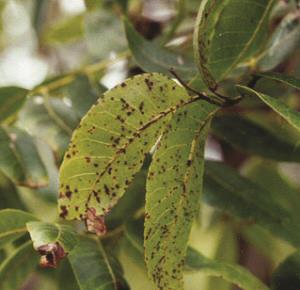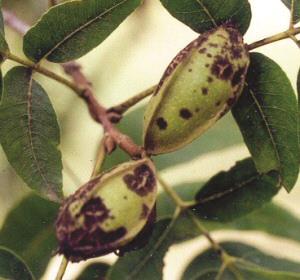Disease Gallery
Disease Details
Pecan Scab
Cladosporium caryigenum
Some varieties are resistant, but many grafted varieties are susceptible. Producers should keep in mind that most commercial varieties were at one time resistant to pecan scab and have now become susceptible because of genetic changes in fungus virulence. Native pecan trees in Oklahoma exhibit a high degree of genetic variability in resistance to scab.
The scab fungus overwinters as a small, tight mat of fungal material called a "stroma" on shucks, leaf petioles and stems infected the previous season. With warmer temperatures and rainfall in the spring, fungal spores are produced on the stroma. Dew and rain spread spores locally within a tree, and the wind spreads them over long distances to adjacent trees or orchards.
First appears as small, circular, olive-green spots that turn to black on the newly expanding leaves, leaf petioles and nut shuck tissue. All tissues are most susceptible when young and actively growing. Lesions expand and may coalesce. Old lesions crack and fall out of the leaf blade, giving a shot-hole appearance. Nut infections cause the greatest economic damage. Early infections may cause premature nut drop but more commonly cause the shuck to adhere to the nut surface, causing sticktights. Late infections can prevent nuts from fully expanding and decrease nut size.

